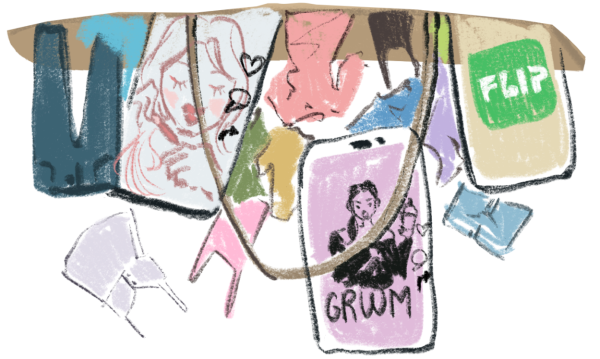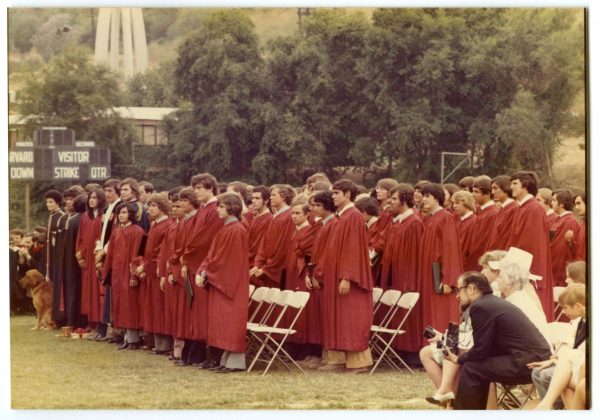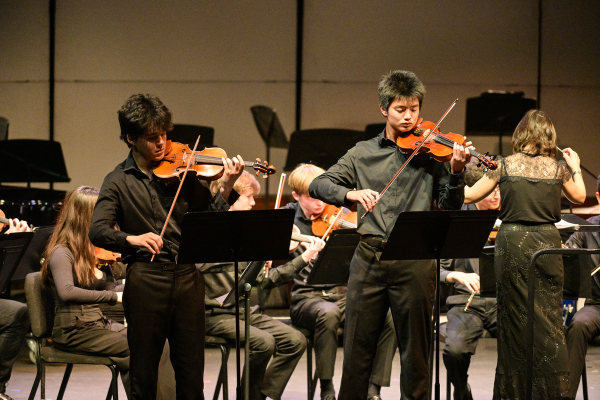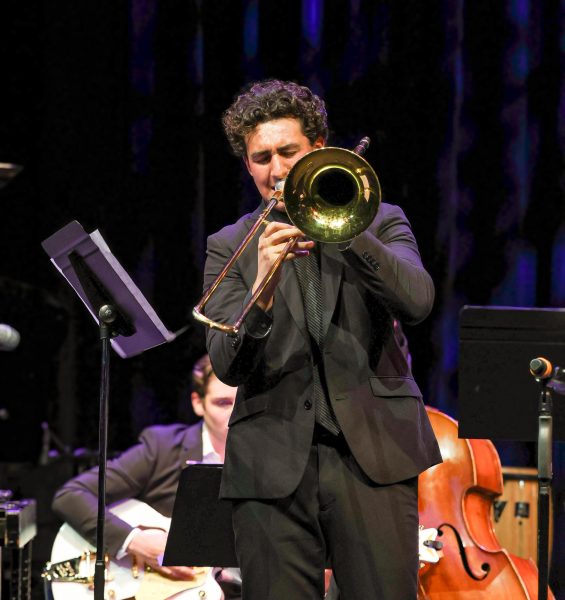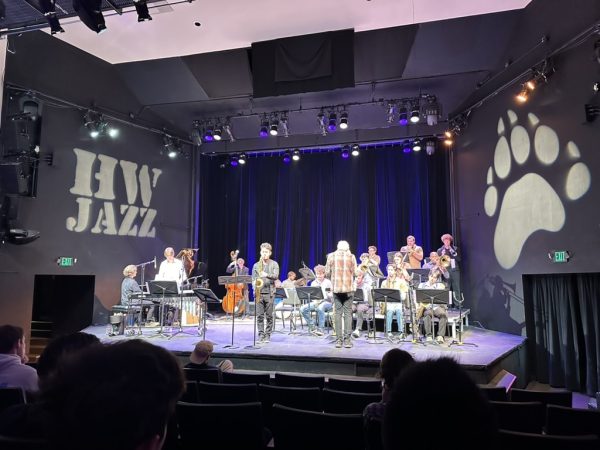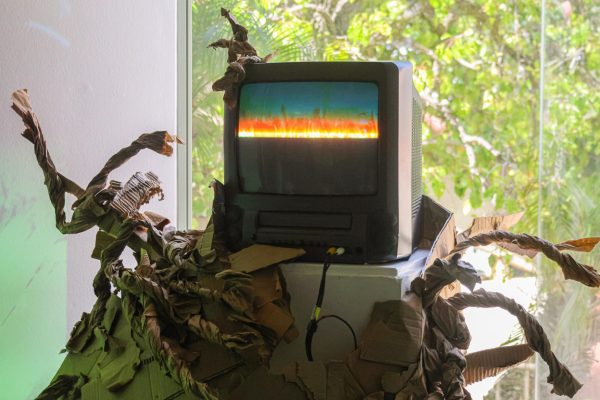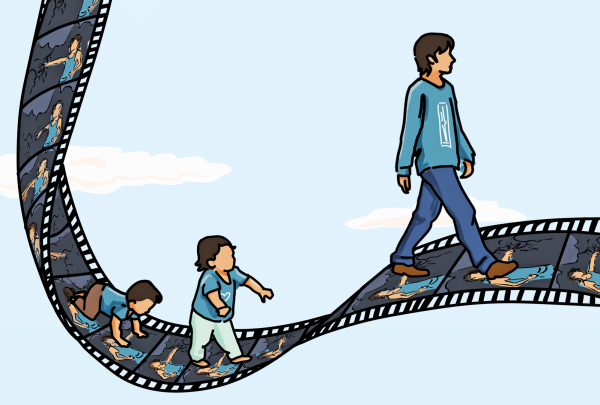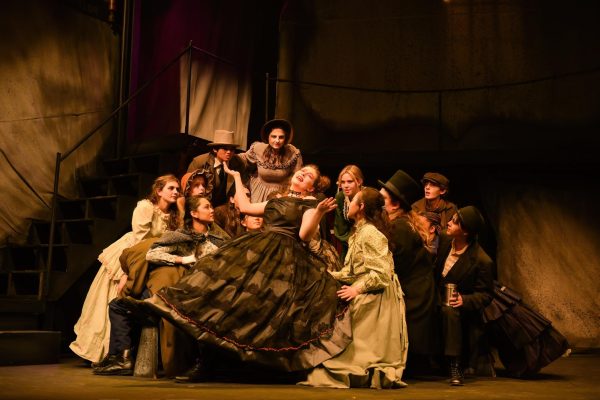Defining Art
December 15, 2021
Busy at work on her next collage, Lena Bagley ’22 cut out grayscale photographs and pasted them onto her canvas. Paintbrushes dried in the sink, the room smelled of acrylic paint and linoleum block prints covered the table in front of her.
Bagley said she hopes to make art that is more than just visually appealing. She said creating abstract art allows her to form work that can be interpreted in various ways.
“With mixed media and abstract art, the art can mean whatever I want it to,” Bagley said. “I might see something completely different than the person next to me, but that doesn’t invalidate either of our perspectives.”
Bagley said abstract art is often dismissed by the general public because it deviates from traditional art styles, but she said she believes abstraction plays a unique and equally important role in the art world as conventional art forms do.
“I think the reason people think of abstract art as ‘easy’ is because it doesn’t require as much technical skill as other mediums,” Bagley said. “However, abstract and unconventional art can be just as complex as traditional forms even if it doesn’t require the same level of training or time.”
Bagley said unconventional art’s value lies in the manner in which it is open to interpretation. As a result, Bagley said viewers should be open-minded about abstraction.
“While ‘weird’ figures and designs might confuse [the viewer], they are essential in conveying certain messages,” Bagley said. “I think abstract art’s greatest feature is that it invites the viewer to come up with their own interpretation of the subject. With abstract art, I don’t feel compelled to find one specific message.”
Upper School Visual Arts Teacher Conor Thompson said it is easy to overlook abstraction because it appears simple at first glance. He said 20th-century painter Piet Mondrian created work that appeared simple but had a deeper meaning.
“When I first saw a Mondrian painting in a book I thought, ‘It’s pretty, but it’s just a bunch of lines and squares,’” Thompson said. “What I didn’t realize is that he had a subtle and sophisticated feeling for surface, texture and paint application.”
Thompson said young people are naturally fascinated by nonrealistic art. He said he introduces the art style to his students to help them break the limits of what art is expected to be.
“I think children understand abstract art intuitively,” Thompson said. “It’s not until we reach early adolescence that we begin to question it, and I think that happens almost universally. It’s very rare for my students to embrace it. I try to frame abstraction for them in terms of music, which is inherently abstract.”
Upper School Ceramics and Visual Arts Teacher Gustavo Godoy said abstract art frames familiar situations in a new way. He said abstract artists challenge the meaning of art as a whole and the forms it can take.
“Abstract art can appear random, but I think it is very specific and not easy at all,” Godoy said. “Each mark or color choice matters. When artists like Helen Frankenthaler, Jackson Pollock or Mark Rothko made gestural, washy or drippy paintings in the 1940s and 50s. They were questioning what art was. They were exploring the meaning of paint on canvas in its purest form.”
Multimedia artist Sadye Lackman ’22 said abstract art is valuable because artists can use abstraction to express emotions that cannot otherwise be represented in realistic artwork.
“Hyper-realism doesn’t always allow you to express all of the emotions that you want to put into a piece,” Lackman said. “The point of abstract art is that it is non-representational. After the invention of the camera, artists realized the point of art wasn’t only to represent the world as realistically as possible.”
Realism artist Page Clancy ’22 said she strives to improve her technical skills by creating art without a deeper meaning in mind. She said through this project she questions the idea that art must have a profound meaning to be considered purposeful and said the meaning of art depends on the emotions it evokes within the person that is examining it.
“People are motivated to find value in art that inspires them or shows them what’s possible,” Clancy said. “Valuable art resonates with people and makes them feel an emotional connection, such as a painting that reminds them of how they feel when they experience anger, fear or a specific moment in their life. That art could provide comfort or inspiration.”
Clancy said it is difficult to form a solid definition of art and the value of art may be influenced by cultural factors. Specifically, she said the Dada movement, which originated during World War I to depict the horrors of warfare, illustrates this idea.
“Good art is hard to define,” Clancy said. “A lot of modern art does not [require a lot of technical skill] but is historically and culturally significant, such as works from the Dada movement. Even if a work of art does not display the technical skill of the artist, expressing an idea from a historical period can make it meaningful to me.”
Abstrat artist Diego Castellanos ’23 said he uses abstract techniques in his work, drawing inspiration from both expressionist and textile artists. Castellanos said artwork is too diverse and multifaceted to be defined simply by the technical skill that is required to make it.
“The difficulty of a work’s creation isn’t directly associated with its value,” Castellanos said. “Abstract art should be judged in its own terms rather than on its ability to imitate the real world. It can attempt to depict non-visual elements of the world such as emotions or even visual elements of the real world, but it doesn’t need to.”
Castellanos said abstract art may require more skill than viewers initially assume. He said technical skill and abstraction are not mutually exclusive and although abstract art may appear simple at first glance, the effort that is required to make abstraction cannot be dismissed.
“I believe that many works that seem easy to make are far more difficult than anticipated,” Castellanos said. “Mondrian’s hard-edge abstract works, for example, are often cited as easy to make, but preventing oil paint from blending to create the hard, precise lines would in fact be extremely difficult.”
Thompson said he encourages students to explore different methods of artistic expression. He said students should avoid limiting themselves to traditional or popular forms of art.
“For students, the experience of creation can be profound and exhilarating,” Thompson said. “Making visual art requires a different part of our brains and enhances learning across the board. I want to encourage my students to be open to abstract art and take it into consideration.”
Clancy said it is easy to judge nonrealistic art because of how different it is from traditional art forms. She said people who scrutinize abstract art fail to understand it on a deeper level.
“[People who denounce] abstract art movements don’t necessarily know enough about them to criticize them,” Clancy said. “Some might say that modern and contemporary works that sell for [high prices] look like a six-year-old could do it. I think that’s biased and it’s a bad way to caricature art.”
































